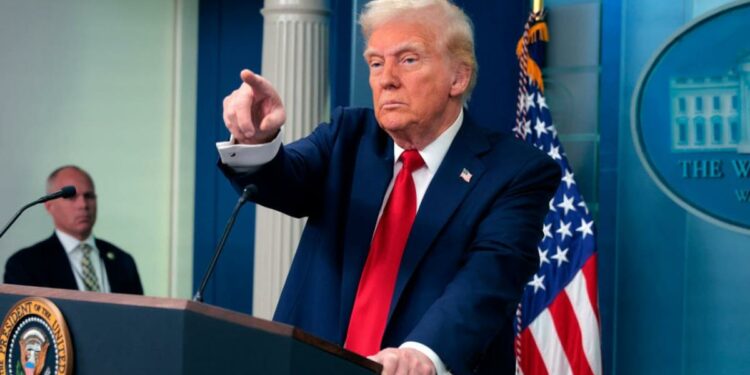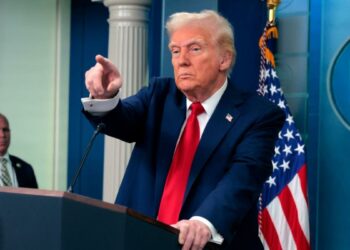The Brief
Trump will impose tariffs on Canada and Mexico starting next month, ending a temporary suspension.
Economists warn the tariffs could raise consumer prices and hurt economic growth.
Canada, Mexico, and other nations may retaliate, potentially leading to a broader trade conflict.
WASHINGTON – President Donald Trump said Monday that his tariffs on Canada and Mexico are will begin next month. His move ends a monthlong suspension on the planned import taxes that could potentially hurt economic growth and worsen inflation.
While Trump was answering a specific question about the taxes to be charged on America’s two largest trading partners, the U.S. president also stressed more broadly that his intended “reciprocal” tariffs were on schedule to begin as soon as April.
Trump has claimed that other countries charge unfair import taxes that have come at the expense of domestic manufacturing and jobs. His near constant threats of tariffs have already raised concerns among businesses and consumers about an economic slowdown and accelerating inflation. But Trump claims that the import taxes would ultimately generate revenues to reduce the federal budget deficit and new jobs for workers.
What they’re saying
“We’re on time with the tariffs, and it seems like that’s moving along very rapidly,” the U.S. president said at a White House news conference with French President Emmanuel Macron.
“The tariffs are going forward on time, on schedule,” Trump said.
What we know
Most economists say the cost of the taxes could largely be borne by consumers, retailers and manufacturers such as auto companies that source globally and rely on raw materials such as steel and aluminum that Trump is already, separately, tariffing at 25%.
Companies like Walmart have warned about uncertainty, while the University of Michigan’s latest consumer sentiment index plunged by roughly 10% over the past month in part due to fears about tariffs and inflation worsening. In the 2024 presidential election, voters backed Trump on the belief that he could cool inflation that had spiked to a four-decade high in the aftermath of the coronavirus pandemic during President Joe Biden’s time in office.
What we don’t know
Investors, businesses and the broader public are still trying to determine whether Trump is merely threatening tariffs as a negotiating tool or if he sincerely backs the tax hikes as a way to offset his planned income tax cuts.
Trump already plans to remove the exemptions on his 2018 steel and aluminum tariffs, taxing imports of both metals at 25%.
Despite talks the Trump administration has held with Canadian and Mexican officials, the U.S. president signaled Monday that he would end the 30-day suspension of tariffs that were initially set to take effect in February. Trump plans to tax imports from Mexico at 25% as well as most goods from Canada, with energy products such as Canadian oil and electricity being tariffed at a lower 10%.
Dig deeper
Trump is placing tariffs on Canadian and Mexican goods with the stated goal of pressuring them to do more to address illegal immigration and the smuggling of illicit drugs such as fentanyl. While relatively little fentanyl comes from Canada, the country announced a czar to address the issue and appease Trump in addition to existing measures. Mexico has relocated members of its National Guard to the border with the United States in addition to existing measures.
Trump also plans to impose new tariffs to match the rates charged by other countries. Set to begin as soon as April, the tariffs could be higher than what other countries would charge as subsidies, regulatory barriers and the value added tax — which is akin to a sales tax common in Europe — would be included in the calculations.
The possibility of retaliatory tariffs planned by Canada, Mexico and Europe could lead to a broader trade conflict that sabotage growth. In February, the Yale University Budget Lab estimated that the Canadian and Mexican tariffs could depress average U.S. incomes by $1,170 to $1,245 a year.
What are tariffs?
The backstory
Tariffs are a tax on imports. Tariffs are typically charged as a percentage of the price a buyer pays a foreign seller. In the United States, tariffs are collected by Customs and Border Protection agents at 328 ports of entry across the country.
Trump has been threatening tariffs to ensure greater cooperation from countries on stopping illegal immigration and the smuggling of chemicals used for fentanyl. Trump has also pledged to use tariffs to boost domestic manufacturing.
RELATED: Fed declines to lower interest rate, ending 3-cut run
U.S. tariff rates vary: They are generally 2.5% on passenger cars, for instance, and 6% on golf shoes. Tariffs can be lower for countries with which the United States has trade agreements. For example, most goods were able to move between the United States, Mexico and Canada tariff-free because of Trump’s US-Mexico-Canada trade agreement. That will change under new tariffs imposed by Trump.
RELATED: Trump proposes abolishment of federal income tax
Trump’s tariffs are an about-face to the trade agreement he himself negotiated with Canada and Mexico in his first term. The USMCA agreement – which he called “the fairest, most balanced, and beneficial trade agreement we have ever signed into law,’’ – was supposed to bring predictability to North American trade, giving businesses the confidence to make investments. It hasn’t worked out that way.
Now, experts say the 25% tax is like launching “a grenade” into the U.S. auto, oil and other major industries.
What items from Canada and Mexico will have tariffs?
What we know
Major imports from Canada and Mexico include cars and trucks, automobile parts, crude oil, and agricultural products.
Details of the new order on Saturday revealed Canadian oil will be subject to a 10% tariff, not 25%, as other Canadian goods.
What we don’t know
It’s still unclear if there will be other exemptions for some products that could result in swift price increases to U.S. consumers.
It’s also unclear if Trump will follow through with threats to impose tariffs on the European Union. He said Friday that he “absolutely” would add tariffs to EU imports, but he didn’t elaborate.
By the numbers
Under 25% tariffs, tariffs would surge from $1.3 billion to $132 billion a year on Mexico’s imports to the United States and from $440 million to $107 billion on Canada’s, according to the tax and consulting firm PwC.
RELATED: What to know about Trump’s interests in Greenland, Panama Canal
In 2023, the U.S. bought more than $45 billion in agricultural products from Mexico –including 63% of imported vegetables and 47% of fruits and nuts. Farm imports from Canada came to $40 billion. A 25% tariff could push prices up.
RELATED: Trump’s no-tax-on-overtime proposal: What to know
In 2023, the United States imported $69 billion worth of cars and light trucks from Mexico – more than any other country — and $37 billion from Canada. Another $78 billion in auto parts came from Mexico and $20 billion from Canada. The engines in Ford F-series pickups and the iconic Mustang sports coupe, for instance, come from Canada.
S&P Global Mobility reckoned that auto “importers are likely to pass most, if not all, of this (cost) increase to consumers.’’ TD Economics notes that average U.S. car prices could rise by around $3,000 – this at a time when the average new car already goes for $50,000 and the average used car for $26,000, according to Kelley Blue Book.
RELATED: Are we in an energy emergency? What Trump’s executive order means
Canada is also by far America’s biggest foreign supplier of crude oil. From January through November last year, Canada shipped the U.S. $90 billion worth of crude, well ahead of No. 2 Mexico at $11 billion.
Why are tariffs controversial?
Trump has said tariffs will create more factory jobs, shrink the federal deficit, lower food prices and allow the government to subsidize childcare.
Tariffs can also be used to pressure other countries on issues that may or may not be related to trade. In 2019, for example, Trump used the threat of tariffs as leverage to persuade Mexico to crack down on waves of Central American migrants crossing Mexican territory on their way to the United States.
Trump even sees tariffs as a way to prevent wars.
“Tariffs are the greatest thing ever invented,’’ Trump said at a rally in Flint, Michigan, during his presidential campaign.
In his first term, Trump imposed tariffs with a flourish — targeting imported solar panels, steel, aluminum and pretty much everything from China.
“Tariff Man,” he called himself.
The other side
Tariffs raise costs for companies and consumers that rely on imports. Mainstream economists are generally skeptical of tariffs, considering them a mostly inefficient way for governments to raise money and promote prosperity. They’re also likely to provoke retaliation.
The European Union, for example, punched back against Trump’s tariffs on steel and aluminum by taxing U.S. products, from bourbon to Harley-Davidson motorcycles. Likewise, China responded to Trump’s trade war by slapping tariffs on American goods, including soybeans and pork in a calculated drive to hurt his supporters in farm country.
A study by economists at the Massachusetts Institute of Technology, the University of Zurich, Harvard and the World Bank concluded that Trump’s tariffs failed to restore jobs to the American heartland. The tariffs “neither raised nor lowered U.S. employment’’ where they were supposed to protect jobs, the study found.
Despite Trump’s 2018 taxes on imported steel, for example, the number of jobs at U.S. steel plants barely budged: They remained right around 140,000. By comparison, Walmart alone employs 1.6 million people in the United States.
Worse, the retaliatory taxes imposed by China and other nations on U.S. goods had “negative employment impacts,’’ especially for farmers, the study found. These retaliatory tariffs were only partly offset by billions in government aid that Trump doled out to farmers. The Trump tariffs also damaged companies that relied on targeted imports.
Who actually pays tariffs?
Big picture view
Trump insists that they are paid for by foreign countries. In fact, it is importers — American companies — that pay tariffs, and the money goes to the U.S. Treasury. Those companies, in turn, typically pass their higher costs on to their customers in the form of higher prices. That’s why economists say consumers usually end up footing the bill for tariffs.
Still, tariffs can hurt foreign countries by making their products pricier and harder to sell abroad. Foreign companies might have to cut prices — and sacrifice profits — to offset the tariffs and try to maintain their market share in the United States. Yang Zhou, an economist at Shanghai’s Fudan University, concluded in a study that Trump’s tariffs on Chinese goods inflicted more than three times as much damage to the Chinese economy as they did to the U.S. economy.
Why you should care
A study this month by Warwick McKibbin and Marcus Noland of the Peterson Institute for International Economics concluded that the 25% tariffs on Canada and Mexico and 10% tariffs on China “would damage all the economies involved, including the U.S.’’
“For Mexico,’’ the study said, “a 25% tariff would be catastrophic. Moreover, the economic decline caused by the tariff could increase the incentives for Mexican immigrants to cross the border illegally into the U.S. — directly contradicting another Trump administration priority.’’
Former trade negotiator Wendy Cutler, now vice president at the Asia Society Policy Institute, said the extent of the economic damage will depend on how long the tariffs are in effect.
If it’s just a few days, “that’s one thing. If they are in place for weeks onto months, we’re going to see supply chain disruptions, higher costs for U.S. manufacturers, leading to higher prices for U.S. consumers,’’ she said. “It could have macroeconomic impacts. It could affect the stock market. Then internationally it could lead to more tension with our trading partners and make it harder for us to work with them.”
The Source
The Associated Press contributed to this report. The information in this story comes from multiple sources, including statements made by former President Donald Trump during a White House news conference with French President Emmanuel Macron, economic analyses from organizations like the University of Michigan, PwC, S&P Global Mobility, and the Yale University Budget Lab, as well as studies conducted by economists from institutions such as the Massachusetts Institute of Technology, Harvard, the University of Zurich, and the World Bank. This story was reported from Los Angeles. Heather Miller and Megan Ziegler also contributed.
Source link : http://www.bing.com/news/apiclick.aspx?ref=FexRss&aid=&tid=67bd35f09c98497ab4dfaf249061bf4b&url=https%3A%2F%2Fwww.yahoo.com%2Fnews%2Ftrump-reinstate-tariffs-canada-mexico-221646958.html&c=15864452979309337637&mkt=en-us
Author :
Publish date : 2025-02-24 09:16:00
Copyright for syndicated content belongs to the linked Source.






